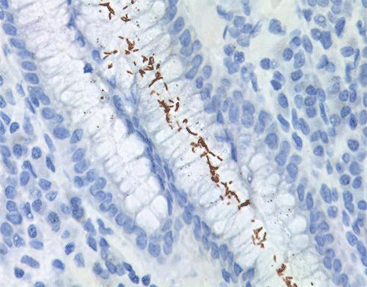 PRODUCT CATEGORY
PRODUCT CATEGORY
CONTACT US
Helicobacter Pylori (polyclonal), RPab
Helicobacter pylori is a kind of curved bend of Gran's negative bacillus, and the occurrence of chronic inflammation of the stomach, duodenum, ulcers and stomach cancer has a certain correlation. The antibody is used to label the surface of epithelial cells in the stomach, duodenum biopsy and Helicobacter pylori in the cytoplasm.
Staining Tissue
[As Figure shows]
Intestine tissue stained with Helicobacter Pylori (Polyclonal)
[Intended Use]
Helicobacter pylori is a kind of curved bend of Gran’s negative bacillus, and the occurrence of chronic inflammation of the stomach, duodenum, ulcers and stomach cancer has a certain correlation. The antibody is used to label the surface of epithelial cells in the stomach, duodenum biopsy and Helicobacter pylori in the cytoplasm.
[Specifications]
| Product Name | Helicobacter Pylori (polyclonal), RPab |
| Catalog No. | CHR-0171 |
| Intended Use | IVD, RUO |
| Species Reactivity | Human; others not tested |
| Cellular Localization | Cytoplasm / Nucleus |
| Antibody Type | Rabbit Monoclonal |
| Clone | Polyclonal |
| Format and Volume | Ready-to-use: 1mL, 3mL, 6mL Concentrated: 0.1mL, 0.2mL and 1mL |
[Datasheets & SDS]
| IVD Datasheet (IFU) | ↕️ Download |
| RUO Datasheet (IFU) | ↕️ Download |
| SDS sheet | check with sales |
[Storage and Validity]
Store at 2~8°C. Avoid freezing.
Maintain temperature below room temperature during transport, ensuring it does not exceed one week.





